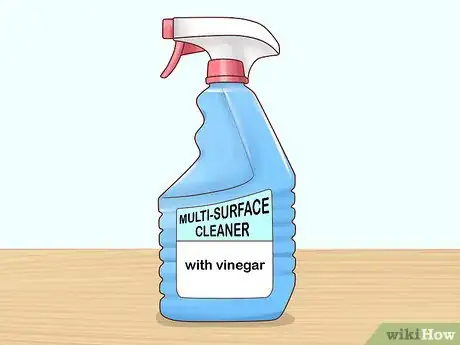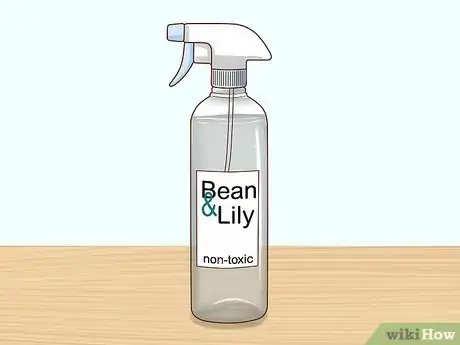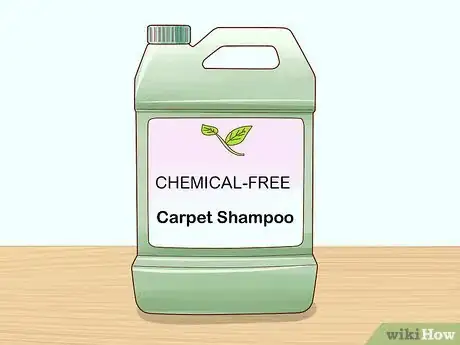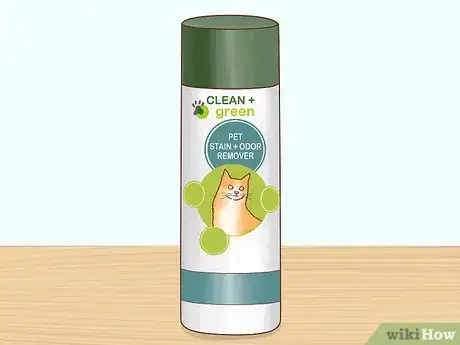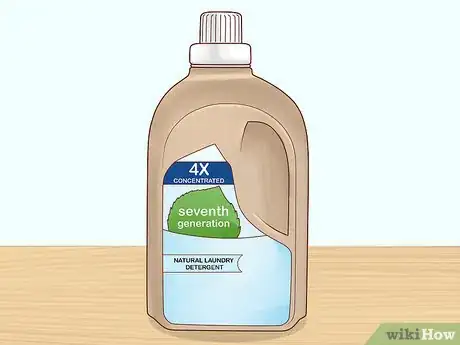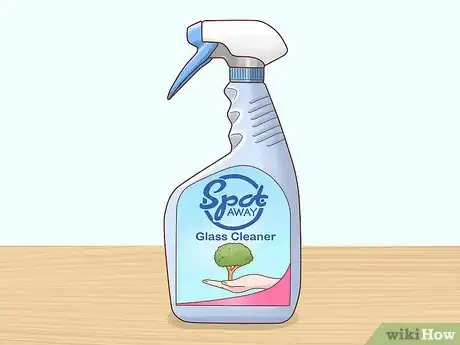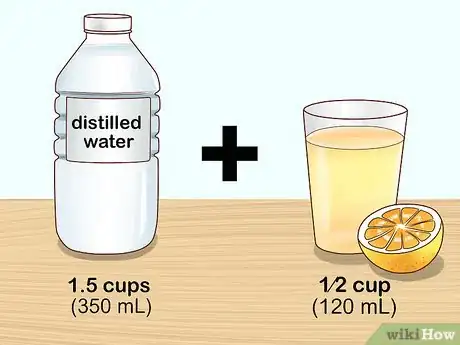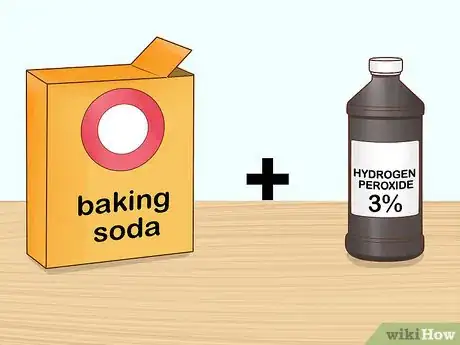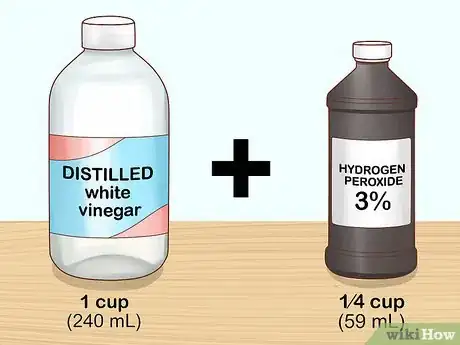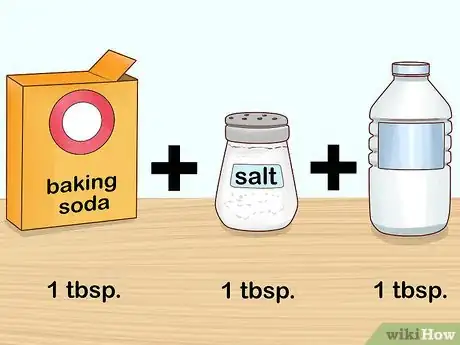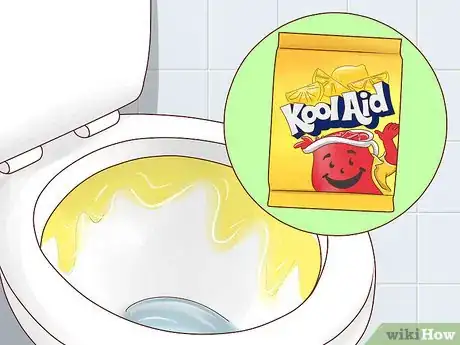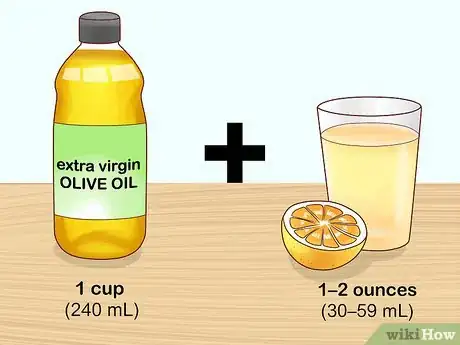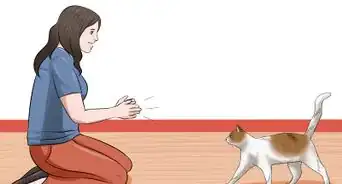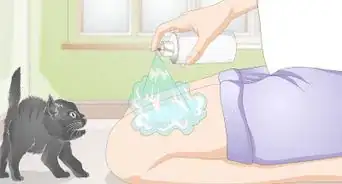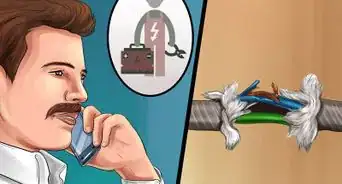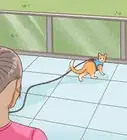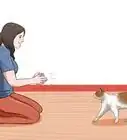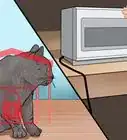This article was co-authored by Laura Smith. Laura Smith is a House Cleaning Specialist and the Owner of All Star Cleaning Services. With over 16 years of experience, her team specializes in providing natural and eco-friendly house cleaning services. All Star Cleaning Services has earned the Association of Residential Cleaning Services International’s (ARCSI) Seal of Approval and maintained an A+ rating with the Better Business Bureau.
There are 16 references cited in this article, which can be found at the bottom of the page.
This article has been viewed 31,934 times.
No matter what measures you take to safeguard your home, it could still be a dangerous environment for your pet cat if you’re using the wrong cleaning products. Ordinary cleaners often contain harsh chemicals that could poison or cause an allergic reaction in curious cats. If you’re looking for a way to keep your living space spotless and your feline friend safe and healthy at the same time, ditch the chemicals in favor of pet-safe products or try mixing up your own cleaning solutions using simple, all-natural ingredients.
Steps
Using Pet-Safe Commercial Products
-
1Look for multi-surface cleaners made with all-natural ingredients. Discard any all-purpose products you currently have in your home that contain ammonia, ethylene acetate, trisodium phosphate, or similar chemicals. In place of these, choose cleaners that feature active ingredients like vinegar, citric acid, and essential oils.[1]
- You can use multi-surface cleaners on any surface in your home, including stainless steel, glass, floors, countertops, and appliances.
- Puracy makes a multi-surface cleaner that’s non-toxic, hypoallergenic, biodegradable, cruelty-free, and completely vegan.[2]
- If you can’t afford to stock up on commercial pet-safe cleaning supplies, you can also try making your own all-natural cleaner.
-
2Shop around for a non-toxic floor cleaner. A good non-toxic floor cleaner, such as Bean & Lily Non-Toxic Floor Cleaner or Eco Me Multi-Surface Floor Cleaner, is essential for any household with pets. Most of the time, these solutions are formulated with ingredients derived from plants. In addition, they dry quickly and evaporate without producing fumes.[3]
- Cats spend a lot of time lying on the floor, so it’s important that the cleaner you choose be gentle on skin and paws.
- Plant-based floor cleaners can be applied to all hard flooring materials, including laminate, vinyl, tile, and genuine hardwood.[4]
Advertisement -
3Switch to a phosphate- and chemical-free carpet shampoo. Cats are known to explore unusual sights and smell by licking them, and carpet is always exposed. For this reason, you want to make sure you’re using a carpet cleaner that won’t make them sick. Many conscientious pet owners swear by brands like Nature’s Miracle for their carpet, rug, and upholstery needs.[5]
- It’s a good idea to keep your cat locked up in another room until your clean carpets have had time to dry, even if you’re using a pet-safe product.
- Ordinary carpet cleaners get their power from perchloroethylene, naphthalene, and ammonium hydroxide. These chemicals can cause symptoms ranging from dizziness, nausea, and lack of appetite to liver damage and even cancer.[6]
-
4Scrub soiled fabrics with an enzymatic stain and odor remover. Enzyme-based products are the way to go when it comes to cleaning fabrics safely. They’re every bit as effective as most chemicals, but they break down quickly after use, which means they won’t linger long enough for inquisitive cats to get into.[7]
- Clean+Green Professional Strength Pet Odor Eliminator and Stain Remover, Eco Care Stain and Odor Remover, and similar enzymatic cleaners are effective on all the most stubborn organic messes—urine, feces, and food-related stains like wine, coffee, and grease.
- Though they’re perfectly safe for most tasks, some enzymes could still make your cat sick if ingested in large quantities.[8]
Warning: Chemical detergents and stain removers are responsible for a large number of accidental pet poisonings every year.[9]
-
5Wash your clothes with plant-based laundry detergent. The cleaning power of pet-approved laundry detergents comes from natural enzymes capable of whisking away dirt, starches, and fats. Since natural detergents don’t make use of artificial dyes and perfumes, they’re better for the wellbeing of both your cat and your clothes in the long run.[10]
- Common Good and Seventh Generation laundry detergents are available in formulas all the way up to 4x concentration, meaning they're strong enough to ensure that even the most well-worn garments come out looking brand new.[11]
- Pick up some chemical-free, non-static dryer sheets to throw in with your clean clothes when they’re ready to go in the dryer.
-
6Use glass cleaners that don’t contain ammonia or other chemicals. Commercial glass cleaners are full of bleach, ammonia, isopropanol, and other potentially harmful chemicals. A better option is a mild, biodegradable solution that will erase streaks and smudges without leaving a toxic residue or releasing fumes into your home.[12]
- SpotAway and Nature’s Source glass cleaning products both come highly recommended by veterinarians.
- For the best value, buy your glass cleaner in a concentrated form and mix it with the recommended amount of water in a spray bottle. It will last longer and prove more cost effective that way.
Making Your Own All-Natural Cleaning Solutions
-
1Mix up an all-purpose cleaner from water and vinegar or lemon juice. Pour 1.5 cups (350 mL) of distilled water into a large spray bottle, along with 1⁄2 cup (120 mL) of distilled white vinegar or lemon juice. Shake the mixture to blend the ingredients and keep the spray bottle on hand whenever you encounter a dingy surface in need of a wipedown.[13]
- You can also use liquid castile soap in place of the vinegar or lemon juice if your prefer. Just don’t use the two together—since one is an acid and the other is a base, they’ll end up canceling each other out.
- Squeeze in a few drops of your favorite essential oil (or a fresh-smelling blend) to make your homemade cleaner more fragrant.
- Your homemade all-purpose cleaner will be safe to use on all non-porous surfaces in your home, from floors and countertops to appliances and natural materials.
-
2Eliminate fabric stains with baking soda and hydrogen peroxide. Start by getting up as much of the mess as you can using a paper towel. Dust the stain left behind heavily with baking soda, then pour a mixture of 3% hydrogen peroxide and all-natural liquid soap over the top. Scrub the stain vigorously, then let the remaining solution sit for 10-15 minutes before wiping or vacuuming it dry.[14]
- This combination of ingredients is also useful for coaxing standing stains out of carpets and rugs.
- You may need to apply your hydrogen peroxide solution more than once in order to remove every last trace of the stain or accompanying odor.
-
3Make a pet-safe bathroom cleaner out of vinegar and hydrogen peroxide. In a large spray bottle, combine 1 cup (240 mL) of distilled white vinegar, 1⁄4 cup (59 mL) of hydrogen peroxide, and 1 teaspoon (4.9 mL) of liquid castile soap. Fill the bottle the rest of the way up with water and shake it thoroughly. Use the solution on showers and shower heads, bathtub liners, sinks, tile, and other smooth bathroom surfaces.
- If your ingredients are limited, it’s possible to make a quick-and-easy solution using equal parts vinegar and water.
Tip: This mixture can also double as a glass cleaner for mirrors, windows, and various appliances.
-
4Combat stubborn messes with a baking soda paste. Combine equal amounts of baking soda, salt, and water in a small container and stir them until they form a thick paste. Use a sponge or cloth to apply the paste to whatever surface needs attention and scrub thoroughly. When you’re done, rinse the surface clean with warm water.[15]
- The exact proportions you use will depend on how much paste you need to clean a given area.
- A simple baking soda scrub can work wonders on dirty appliances, as well as marble and stone countertops, ceramic, stainless steel, and your cat’s food and water dishes.[16]
-
5Use Tang or Kool-Aid to keep your toilets clean. Sprinkle the drink mix over the inside of the toilet bowl, aiming to cover as much of the surface as you can. After about an hour, flush the toilet and watch it sparkle. If you’re dealing with stuck-on stains, go over the bowl with a toilet brush before you flush the drink mix.[17]
- The high concentration of citric acid in fruit-flavored drink mixes is effective for busting up stains caused by hard water, rust, and a variety of other yucky substances.
- An added benefit of using powdered drink mix is that cats tend to dislike the scent of citrus, which means they won’t be tempted to drink out of the toilet while it’s soaking.[18]
-
6Polish wood surfaces with olive oil and lemon juice. To make a DIY furniture polish that won’t pose a risk to your pet cat, simply stir 1–2 fluid ounces (30–59 mL) of fresh lemon juice into 1 cup (240 mL) of extra virgin olive oil. Use a clean, lint-free cloth to spread on a thin coating of polish on the wood surface, then wipe off the excess and allow it to soak in.[19]
- While you’re at it, try out your oil polish on cutting boards and wood siding and accents.
- The acidic lemon juice will gently clean and disinfect, while the oil will act as a conditioner to preserve the strength and luster of the wood.
Community Q&A
-
QuestionCan ivy be fatal to a kitten?
 LilyTop AnswererYes. English ivy is definitely fatal. Symptoms include rashes, drooling and being hoarse or weak at the mouth.
LilyTop AnswererYes. English ivy is definitely fatal. Symptoms include rashes, drooling and being hoarse or weak at the mouth. -
QuestionI have a cat. What safe, non-toxic cleaner can I use for my kitchen floor?
 Community AnswerTry Bona Floor Cleaner. I have laminate flooring, but they also carry a kind for hardwood floors.
Community AnswerTry Bona Floor Cleaner. I have laminate flooring, but they also carry a kind for hardwood floors. -
QuestionIs dettol disinfectant toxic to cats?
 Community AnswerYes.
Community AnswerYes.
Warnings
- Keep an eye out for signs that your cat has been exposed to hazardous household cleaners. The most common symptoms are vomiting, diarrhea, disorientation, and irritated or blistered skin.[20]⧼thumbs_response⧽
- Some cats may be allergic to natural compounds, like those found in citrus or essential oils. If your cat begins sneezing, coughing, or vomiting uncontrollably, or if it appears to have trouble breathing, contact your veterinary specialist right away.⧼thumbs_response⧽
References
- ↑ https://www.purewow.com/home/pet-friendly-detergents-cleaners
- ↑ https://www.bestproducts.com/lifestyle/pets/g3443/pet-safe-non-toxic-cleaning-supplies/
- ↑ https://www.bestproducts.com/lifestyle/pets/g3443/pet-safe-non-toxic-cleaning-supplies/
- ↑ https://www.rover.com/blog/16-pet-safe-non-toxic-cleaners-love/
- ↑ http://www.safebee.com/home/clean-carpet-healthy-pets-how-have-both
- ↑ https://my.clevelandclinic.org/health/articles/11397-household-chemical-products-and-their-health-risk
- ↑ https://mom.me/pets/19133-non-toxic-cleaning-products-pets/item/4/
- ↑ https://my.clevelandclinic.org/health/articles/11397-household-chemical-products-and-their-health-risk
- ↑ https://www.catster.com/cat-food/household-hazards-for-cats
- ↑ https://www.purewow.com/home/pet-friendly-detergents-cleaners
- ↑ https://www.businessinsider.com/best-cleaning-products-pets
- ↑ https://mom.me/pets/19133-non-toxic-cleaning-products-pets/item/9/
- ↑ https://livingthenourishedlife.com/homemade-diy-natural-all-purpose-cleaner/
- ↑ https://www.onecrazyhouse.com/hydrogen-peroxide-cleaning-recipes-to-clean-almost-everything/
- ↑ https://www.cesarsway.com/dog-care/safety/tips-for-safer-cleaning
- ↑ https://consciouscat.net/2012/08/28/cat-friendly-cleaning-products/
- ↑ https://www.apartmenttherapy.com/tang-for-your-tank-38040
- ↑ http://www.cat-training.com/smells-that-cats-hate
- ↑ https://consciouscat.net/2012/08/28/cat-friendly-cleaning-products/
- ↑ http://www.pethealthnetwork.com/dog-health/dog-toxins-poisons/household-cleaning-products-and-your-pet-what-you-should-know-about
About This Article
To clean your home with cat-safe detergents, try using water, white vinegar, and lemon juice as an all-purpose cleaner. Or, if you need to clean stains out of upholstered furniture or carpet, pour baking soda and hydrogen peroxide over them and let it sit for 10-15 minutes. You can also clean tiles, tubs, and sinks using hydrogen peroxide, white vinegar, and liquid soap. To learn how to clean using pet-safe commercial cleaning products, keep reading!
